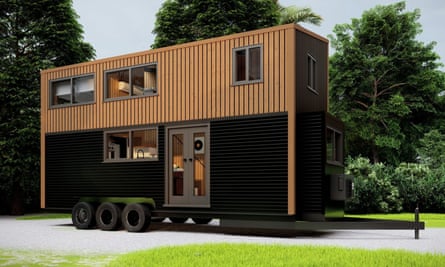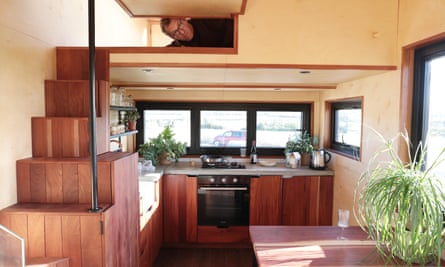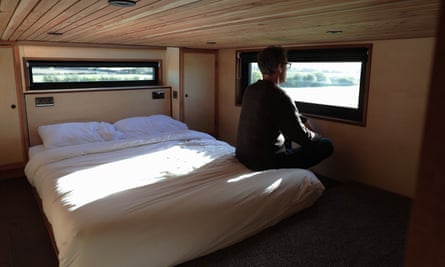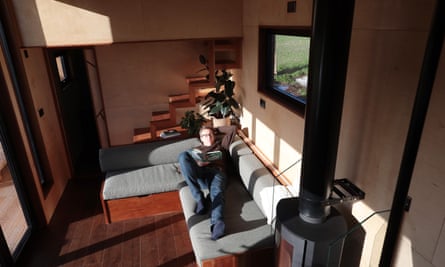You might bump your head, and the wheels betray its caravan roots, but it’s yours – and that’s the key for a growing number of people fleeing the UK housing crisis in a “tiny home”.
Factory-built, shaped to a lorry’s dimensions so that they can pass under road bridges, and styled to feel like a backwoods cabin, tiny homes are attracting people struggling to afford soaring rents, living in vans or whose hopes of buying have evaporated with rising interest rates.
This week, the Office of National Statistics revealed a rise of 19,000 households in England and Wales living in caravans or other temporary or mobile structures in the last decade. Home ownership is falling and since 2001, the number of households renting has more than doubled. The world’s richest man, Elon Musk, reportedly bought a tiny home to use at his Texas spaceport, but for most people the motive is more prosaic: overcoming the fact that across large areas of the UK, including in Manchester, Bath, Nottingham, Cardiff, Brighton and Exeter, average rents are now classed as unaffordable.
A scheme is under way to build up to 15 tiny houses on a former council site in Bristol. Startup companies are offering to deliver tiny homes for prices ranging between £30,000 and £100,000, depending on finish. Cornwall council has installed 15 SoloHaus units in Truro as “move on” housing for some of the 730 households in the county currently in temporary or emergency accommodation. And thirtysomethings despairing at their prospects of owning a home are tapping up friends and farmers for pockets of land on which to park a factory-built house.
 View image in fullscreenThom Barber and his partner, Olivia. Photograph: supplied
View image in fullscreenThom Barber and his partner, Olivia. Photograph: supplied
“I think a lot more people are going to go down the small house route,” said Thom Barber, 33, a former British army soldier and now lorry driver who is planning to move into a £30,000 tiny home in a site on his parents’ land in Yorkshire next summer. “A lot of my friends are in camper vans at the moment.”
Barber is looking to buy a unit from Ross Clarke, who runs Minor Homes, a new company that has supplied timber-frame units to clients in Oxfordshire and Dorset. They can be hooked up to mains electricity and water, with sewage through a cesspit.
Barber is driven by a desire to “get self-sufficient and use less stuff”, and to own a mobile property that will provide him and his family with resilience in the face of future employment and financial shocks.
He is one of millions of people on the wrong end of a huge generational wealth shift that has created the need for options such as tiny homes. His parents “did well, buying and selling houses,” and he grew up in a seven-bed Victorian property, but now he says “I can’t even afford a one-bedroom apartment” despite working solidly “six or seven days a week”.
Janie Harper, 33, a project manager in Dorset who has been living in a van after finding rent unaffordable since divorcing her husband with whom she shared a four-bedroom house, plans to move into a £50,000 tiny home next spring, which she intends to locate on a friend’s land.
 View image in fullscreenJanie Harper hopes to move out of her van and into a tiny home. Photograph: supplied
View image in fullscreenJanie Harper hopes to move out of her van and into a tiny home. Photograph: supplied
She wants to stay in the Lyme Regis area but said that with so many second homes in the area, rent was unaffordable at about £1,300 a month. “I never thought that I would be in a position in my 30s when I wouldn’t have anywhere permanently to live,” she said.
By no means a cure-all for the UK’s housing affordability crisis, the emergence of tiny home experiments nevertheless probes at several of its root causes, including the inflexibility of planning laws and the cost of land.
Tiny homes have an ambiguous planning status. Some authorities have required planning consent for a dwelling, on occasion insisting on retrospective planning applications if approval hasn’t been sought.
Clarke said that if a tiny home was located on agricultural land and the resident had a smallholding, then it could be allowed on the basis that they need to live there to look after the land. He said a tiny house could be classed as a static caravan, but he wants the government to consider them as a new separate planning class because they have architectural merit.
“We want to build these for people that want to live in them [as opposed to using them as spare bedrooms],” he said. “We want to bridge that gap between people that feel like they’re living transiently – on a narrowboat, in vans or caravans – into living with a feeling of permanence or semi-permanence.”
 View image in fullscreenA custom-designed tiny house. Photograph: Tiny Housing Co
View image in fullscreenA custom-designed tiny house. Photograph: Tiny Housing Co
Tiny house life has the hallmarks of a social movement, he said. “Living simply, consuming less, and being more connected to nature are all intrinsic values,” he said. “Tiny houses today can be defined as architecturally relevant houses, less than 400 sq ft, that are built off site, not connected to the ground with foundations and are movable.”
Rachel Butler, 53, from Bristol is a founder, director and co-project manager of the Tiny House Community, a planned scheme of up to 15 tiny houses on a former council site that was released by the local authority for housing. She has been paying more than £1,500 a month in private rent for herself and her 19-year-old daughter, and recently came close to homelessness because it was so hard to find an affordable property.
 View image in fullscreenA tiny home in transit. Photograph: Tiny Housing Co
View image in fullscreenA tiny home in transit. Photograph: Tiny Housing Co
They are trying to build the homes for less than £2,000 per sq metre, partly by recycling from construction sites, and rents will range from £350 to £500 a month, with some will be available for shared ownership. The council is waiving its minimum space standards as there are extensive communal facilities planned.
She said key reasons for choosing to build tiny homes were the idea of “sufficiency, having enough not too much”, limiting the use of resources so “we’re not going to be overshooting planetary boundaries,” and keeping costs down so homes are genuinely affordable.
“It’s not about trying to accumulate tons and tons of stuff to feel safe,” she said. “It’s about living in a community to feel safe and to bring that resilience together.”
She said she and her daughter were ready to squeeze up in a smaller home. “She’s very accepting of it all,” she said. “She understands how tough it is out there to get your own home.”
A night in a tiny home
 View image in fullscreenRobert Booth in his borrowed tiny home. Photograph: Martin Godwin/The Guardian
View image in fullscreenRobert Booth in his borrowed tiny home. Photograph: Martin Godwin/The Guardian
On the edge of an Oxfordshire barley field, the first thing you notice about the tiny home at Latchford farm is its lorry trailer silhouette. This wooden-clad abode was towed here from a factory, ready to be plugged into mains and water. It has aspirational features such as bifold doors, a firepit and rusticated timber cladding, but it also has the exact shape of a freight wagon so it can fit along lanes and under bridges, complete with overhang under which a truck rig connects.
An apron of decking has been laid around the unit so its wheels are visible from only one end, making it is easy to forget this is essentially a trailer home. But even without the added outside space (featuring a sunken bath that looks promising for stargazing), the indoors experience is more house than caravan. There is no wobble, the solid double-glazed doors close with a thud not a rattle, and it is well insulated and cosy, with a single infrared heater powered from a mains hookup. The wood burner in the living area would probably be redundant for all but the coldest days.
 View image in fullscreenTaking in the view from the bedroom. Photograph: Martin Godwin/The Guardian
View image in fullscreenTaking in the view from the bedroom. Photograph: Martin Godwin/The Guardian
Perched above the overhang is the bedroom. The sleeping quarters are up a tiny twisting staircase with a mere couple of feet of headroom, but enough for a bed and some well-considered lighting. I immediately wonder if storage wouldn’t be a problem if I were making this home for more than a night. The cupboard might serve as wardrobe for a pixie, but not much else. The second bedroom, tucked above the bathroom at the other end, is even more snug, but both are comfortable.
The bespoke fitted kitchen with gas burners (Calor tanks at the back), fridge and plenty of cupboards would serve a couple or, at a push, a small family. The bathroom might even be too spacious, with a walk-in shower and room for potted plants. The triumph, though, is the central high-ceiling living space, completely demolishing any notion of hunkering down in a caravan or tent. Windows are punched into the facade all over, creating zen views and bringing light in. This is a version with a high-spec finish and would cost about £100,000. A shell with utilities is less than half the price.
 View image in fullscreenThe triumph is the central high-ceiling living space. Photograph: Martin Godwin/The Guardian
View image in fullscreenThe triumph is the central high-ceiling living space. Photograph: Martin Godwin/The Guardian
This example has a contested planning status. With its workshop-fresh timber cladding, it is striking, but no more so than a farm building or caravan. If planners want to boost affordable housing then finding ways to accommodate these kinds of tiny houses with some sort of planning dispensation for gardens, corners of unused agricultural land or brownfield sites may be an answer.




